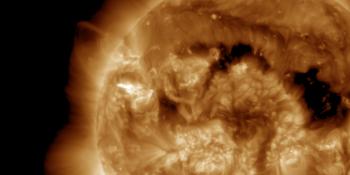Przeglądasz Archiwum z czwartek, 12 lipca 2012
Raport aktywności słonecznej
Każdy wspomniany rozbłysk słoneczny w tym raporcie ma współczynnik skalowania dodany przez Space Weather Prediction Center (SWPC). Przez skale współczynników SWPC, raporty o rozbłyskach słonecznych są o 42% mniejsze niż naukowo jakościowa data. Skale współczynników zostały usunięte z naszych archiwów o rozbłyskach słonecznych by odzwierciedlić prawdziwe jednostki fizyczne.
Raport aktywności słoneczno- geomagnetycznej 2012 Jul 12 2200 UTCPrzygotowane przez NOAA © SWPC i przetworzone przez SpaceWeatherLive.com
Połączenie raportów USAF/NOAA o słonecznej i geofizycznej aktywności
Numer SDF 194 wydany w 2200Z na 12 Jul 2012IA. Analiza aktywności regionów słonecznych i aktywność od 11-2100Z do 12-2100Z Solar activity was high. At 12/1649Z, a long-duration
X1/2b flare was observed from Region 1520 (S16W09). The event was
visible in GONG H-alpha imagery as a bright ribbon flare that
erupted along the region?s long E/W oriented inversion line.
Associated with this event were Type II (1268 km/s) and Type IV
radio emissions along with an 800 sfu Tenflare. Limited satellite
imagery indicated a CME was associated with this event. STEREO
Behind COR2 imagery observed a CME lifting off the west limb, first
visible at 12/1710Z. Further analysis of this CME is ongoing.
During the past 24 hours, Region 1520 grew in both area and spot
count and maintained a complex beta-gamma-delta magnetic
configuration. Region 1521 (S21W21) also grew in area and spot
count and remained a beta-gamma magnetic classification. New
Regions 1522 (N13W21) and 1523 (S27E31) emerged on the disk as
simple bi-polar spot groups.
IB. Prognoza aktywności słonecznej
Solar activity is expected to be
moderate with a chance for X-class events for the next three days
(13 - 15 July).
IIA. Podsumowanie aktywności geofizycznej 11-2100Z do 12-2100Z
The geomagnetic field was at quiet to active levels with isolated
high latitude major storm intervals from 11/0600 - 1200Z. ACE solar
data indicated wind velocities decreased steadily through the period
from 500 km/s to near 400 km/s while the Bz component of the
interplanetary magnetic field did not vary much beyond +/- 5 nT.
The greater than 10 MeV proton flux at geosynchronous orbit exceeded
the 10 pfu event threshold at 12/1835Z. At the time of this report,
flux levels were at 35 pfu and rising. The greater than 100 MeV
flux at geosynchronous orbit was enhanced, but below event threshold
levels of 1 pfu. The greater than 2 MeV electron flux at
geosynchronous orbit reached high levels during the period.
IIB. Prognoza aktywności geofizycznej
The geomagnetic field is
expected to be at mostly quiet to unsettled levels for day one (13
July). Unsettled to active levels, with isolated minor storm
intervals, are expected on days two and three (14 - 15 July) as
effects from the 12 July CME are expected to become geoeffective.
III. Prawdopodobieństwa zdarzenia 13 Jul do 15 Jul
| Klasa M | 80% | 80% | 80% |
| Klasa X | 35% | 35% | 35% |
| Proton | 99% | 99% | 50% |
| PCAF | red | ||
IV. Przepływ 10,7 cm z Penticton
Zaobserwowano 12 Jul 165 Przewidywane 13 Jul-15 Jul 165/165/165 Średnia z 90 dni 12 Jul 127
V. Indeks geomagnetyczny A
Zaobserwowano Afr/Ap 11 Jul 010/012 Szacowane Afr/Ap 12 Jul 009/011 Przewidywane Afr/Ap 13 Jul-15 Jul 006/008-015/018-013/015
VI. Prawdopodobieństwa aktywności geomagnetycznej 13 Jul do 15 Jul
| A. Średnie szerokości geograficzne | |||
|---|---|---|---|
| Aktywne | 20% | 40% | 35% |
| Słaba burza | 05% | 15% | 10% |
| Bardzo znacząca burza | 01% | 01% | 01% |
| B. Wysokie szerokości geograficzne | |||
|---|---|---|---|
| Aktywne | 20% | 10% | 15% |
| Słaba burza | 25% | 30% | 30% |
| Bardzo znacząca burza | 25% | 55% | 45% |
Wszystkie czasy w UTC
<< Idź do codziennego przeglądu
Najnowsze wiadomości
Najnowsze wiadomości z forum
AR 3959 5SEEDS is down? 18Space Weather Memes 653IP cameras for sky surveillance 38Incoming & Unnumbered Active Regions 1399
Więcej tematówWesprzyj SpaceWeatherLive.com!
Wielu ludzi odwiedza SpaceWeatherLive aby śledzić aktywność słoneczną lub sprawdzić czy jest szansa na zaobserwowanie zorzy polarnej. Niestety, większy ruch na stronie oznacza większe koszty utrzymania serwera. Dlatego, jeśli jesteś zadowolony ze strony SpaceWeatherLive, zachęcamy do wspierania nas finansowo. Dzięki temu będziemy mogli utrzymać naszą stronę.

Fakty na temat pogody kosmicznej
| Ostatnie rozbłyski klasy X | 2025/01/04 | X1.85 |
| Ostatnie rozbłyski klasy M | 2025/01/09 | M1.1 |
| Ostatnia burza geomagnetyczna | 2025/01/04 | Kp5 (G1) |
| Dni bez plam słonecznych | |
|---|---|
| Ostatni dzień bez skazy | 2022/06/08 |
| Średnia miesięczna liczba plam słonecznych | |
|---|---|
| grudnia 2024 | 154.5 +2 |
| stycznia 2025 | 144.5 -10 |
| Ostatnie 30 dni | 151.1 +32.8 |


